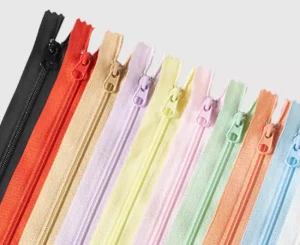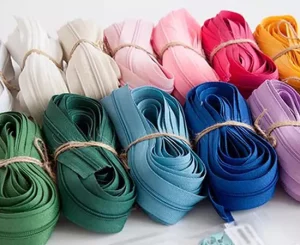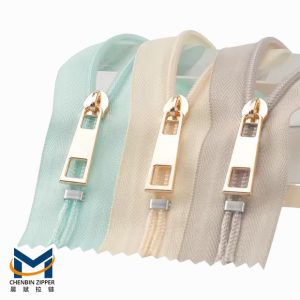The Fascination of Coil Zippers
Coil zippers are one of the central characteristics of contemporary clothing and numerous manufacturing spheres since these zippers are unique in their way. Most notably, coil zippers are distinguished by the fact they have a sheer coil, which is typically made from nylon or polyester. As a result, these zippers are much lighter than their metal counterparts are, and their structure provides them with increased flexibility, allowing for their use in a range of sophisticated fashion ideas and entirely utilitarian purposes.
The Evolution of Zipper Design
Zippers have undergone a great change since and after its invention, among which coil zippers become the best-favored choice of fashion designers and clothing manufacturers. The original zippers were mostly made of metal; they were heavy and rather cumbersome. With the advance in fashion as well as technology, coil zippers had been developed; the design was more dynamic and offered allowance for humps and varying fabric weight. The coil zipper is no longer just an invention for function; it has become a focus for aesthetics, offering the designer a smaller and more concealed zipper to use, which allows clothes to enjoy added style. The design of zippers, more especially the coil structure continues to drive the garment or fashion industry to new heights, while providing designers with still many more options.
Applications in Modern Fashion and Beyond
Coil zippers are widely used, which makes them one of the most versatile types of closures. In the fashion industry, it can be a dress or a jacket, as coil zippers will provide a closure that is not too catchy and quite reliable. At the same time, such industries as equipment and furniture production, as well as leather goods, are enjoying the benefits of coil zippers, as they have the necessary durability and flexibility. Such production, such as CHENBIN Zipper, which offers a wide range of various zipper products and also produces waterproof, as well as hidden closures, indicates that such function is widely used in many other areas, not only clothing.
Core Components of Coil Zippers
To understand coil zippers more thoroughly, it’s essential to delve into their core components, which consist of several key elements that work harmoniously together.
Essential Elements
Slider Mechanism
A slider is a component necessary for the functioning of any zipper, including the coil zipper. It allows safely to open and close the zipper whenever you need to. However, as the slider is the thing which contacts the teeth coils, its material and design influence the zipper more than any other components.; thus, the high-quality slider makes the coil stay engaged and ensures lasting and reliable operation of the zipper.
Tape Material
For coil zippers, the choice of tape material is quite diverse, and the two most frequently used options are nylon and polyester. The importance of the tape material becomes evident when considering the opening and closing mechanism of the zipper. The companies producing coil zippers pay close attention to the quality of the tape material, so the zippers can not only be effective in use but also look smooth and nice, blending properly with the fabric they are sewed on.
Teeth Configuration
The configuration of teeth is a distinguishing characteristic of coil zippers that helps differentiate them from other types of zippers. Unlike most other types that contain individual teeth, coil zippers have a single continuous coil that provides for smoother engagement or disengagement of the zippers. The unique structure and additional flexibility of coil zippers can be advantageous for some implementations, such as when a snug fit is necessary. However, for most uses or tasks, the choice of this type of zipper is mainly related to prior experience and does not currently have substantial advantages.
Revolutionizing Manufacturing Techniques for Coil Zippers
Modern technology has changed all manufacturing products, including coil zippers. Modern ways to produce coil zippers are technological and the material usages that are used to produce zippers are selected to support these new techniques, to increase the quality and ease of the produced zippers. To discuss how coil zippers are produced through modern technology, materials, techniques, and machinery, a substantial assessment is made below. Coil zippers are produced by using new technology sewing machines which allow effectively making sewn products inside as well as outside. This manufacturing technique utilizes enhanced coil zipper material which increases the quality and durability of the produced zippers. In the first stage, the spiral coil of the zipper is earned, and then both sides of the zipper are sewed. In addition to that, attaching any type of puller head is simple and convenient. By considering the following way that zippers are produced it is possible to summarize the employment of new technology sewing machines which enable the sewing the zipper outside and inside of the coat while the side are sewn with a lasting stitch. During production, besides attaching coil zippers, the film zipper is welded ultrasonically, while the asymmetric zipper is sewed directly to the respective fabric.
Advanced Materials in Coil Zipper Production
Exploring High-Performance Materials
The manufacturing of coil zippers has been greatly revolutionized by the advancements in materials and technologies. High-performance materials have made zippers stronger and provide a better experience for users. Some of the optimal materials in this regard are samples of nylon and polyester. In present-day manufacturing, such materials are the best feature due to their lightweight, flexible properties. In particular, there are nylon coil zippers now available on the market. They have a smooth finish and run easily, making them an icon of textiles, and a high frequency of usage in such applications as garments and outdoor gear.
Nylon and Polyester Variations
Distinct advantages are offered in the production of coil zippers in nylon and polyester variations. The first is generally appreciated for being relatively abrasive and stretch-resistant, offering an effective fabric-like feeling that retains the secure closure and adapts well to hugging the item. Polyester coil zippers, in turn, have a tendency to become even more colorfast and UV resistant, and thus are suitable for items that will be exposed to more sunlight. Finally, both of these options can be treated with different coatings, accordingly enhancing resistance to some environmental effects such as moisture, temperature variations, etc.
Eco-Friendly Alternatives
With increasingly voiced environmental concerns, the zipper manufacturing sector has seen the introduction of eco-friendly materials. In the case of coil zippers, this would be the utilization of recycled polyester and bio-based nylon. By choosing the new materials, companies achieve a certain decrease in reliance on finite resources while additionally reducing waste. Both alternatives can provide quality and performance no worse than traditional nylon or polyester while satisfying the demands of eco-aware consumers. Thus, more consumers are turning to eco-friendly manufacturing.
Future Perspectives: Trends and Predictions in Coil Zipper Industry
The changes in technology and the development of innovative products in the coil zipper industry are poised for remarkable changes. Manufacturers in this industry have no alternative than to be innovative in their productions, as new advancement arises each given time. Innovative practices are essential in this industry, and emerging issues require industry players to keep abreast with modern practices and materials while responding to consumer preferences.
New Technological Developments on the Horizon
Emerging technologies are shaping how coil zippers are being manufactured through automation and state-of-the-art techniques of production. Previously it was made using 3D printing which can also be imposed on developing such zippers. In addition to this, the use of smart zippers, which are based on the idea of monitoring, to which extent, they are being used. Such zippers may be also used in the previous examples of their use in the fashion and outdoor industry.
Evolving Market Demands and Consumer Preferences
There is a trend in the coil zipper market towards customization and personalization. In the modern world, consumers strive for products that are not unique but also functional. At the same time, customers use coil zippers in different ways, meaning that their needs are continuously changing. Therefore, it becomes a good opportunity for manufacturers to present customers with more chances for custom zippers. These choices are often related to zipper length as well as color and finish, which can meet specific consumer needs. In addition, manufacturers need to take a more sustainable approach and introduce eco-friendly materials.






